Our home from 1988 to 2006
Often written as 6D Handley in the past,
and even appearing that way on local signposts, the love of money has
nothing to do with the name of the village, which is derived from the
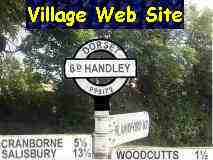 two medieval hundreds of Sexpene and Hanlege
two medieval hundreds of Sexpene and Hanlege
SixpennyPen Hill (in Sutton Waldron) was earlier called Seaxpenn 932 (in a later copy of an Anglo-Saxon charter), meaning 'hill of the Saxons', from Old English Seaxe and Celtic penn. The hill may have marked an ancient Saxon boundary. It was also an old hundred meeting place, giving its name Sexpene to a Domesday Book hundred that was later combined with Handley hundred to form the hundred of Sixpenny Handley.
HandleyHanlee 877 (in a later copy of an Anglo-Saxon charter), Hanlege 1086 (Domesday Book), Henle 1182, Handeleygh 1496, Sexpennyhanley 1575. 'The high wood or clearing', from Old English heah and leah.
Note that the -d- only appears at the end of the 15th century, and that 'Sixpenny' is first added in the 16th century (from the name of the hundred of Sixpenny Handley).
It was one of the homes of the dreaded Isaac Gulliver [1745-1822] whose smuggling
operations spread from Poole to Lyme Regis. He married innkeeper's
daughter Betty Beale at Sixpenny Handley parish church [5 October
1768]. His father-in-law's hostelry, the Blacksmith's Arms, Thorney
Down, was on the main road from Blandford to Salisbury and
horse-shoeing was William Beale's other trade.
Those who think that smuggling has, of necessity, to be carried on somewhere near the sea,
might note that Sixpenny Handley is around 30 miles inland, which is
a long way to travel, loaded and under cover of darkness. Gulliver,
though he had a liking for spirits and lace, might well have had
another string to his bow - an enterprise founded on the availability
of deer on the Chase ... and a tomb adjoining the local church where
'hot' venison could be stored for the duration of the hue and cry.
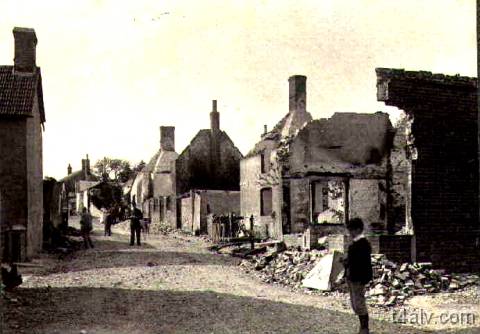
In 1892, the village suffered a devastating fire, in which more than 200 people were
rendered homeless and destitute. It's surprising to learn there were
that many villagers - they must have lived about 20 to the house -
but something about the tragedy caught the public imagination because
people rallied around, and it was said that you could always tell a
Sixpenny Handley man for some time afterwards because he usually wore
two if not three waistcoats.
A great deal of money was collected and when all claims were met, there remained at least
£1,000. But so much squabbling arose over how this large (in
those days) sum was to be spent that it was put into Chancery and
remained there, possibly to this day.
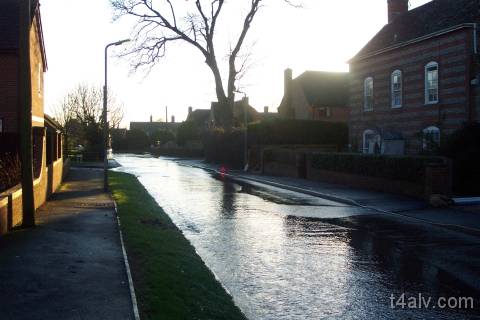
In more recent times the lower part of the village has been subject to flooding on a number of occasions - this photo on Dean Lane was taken in January 2003.
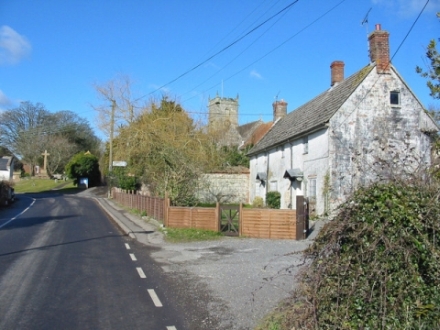
These two photos show the High Street, looking towards the top of the village, with the Church tower in the background.
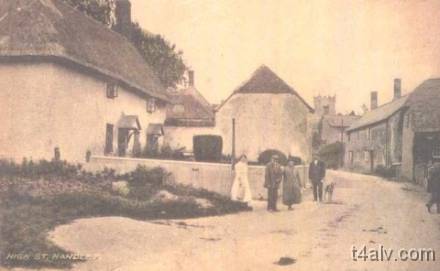
Photo by Clive Perrin
For many years the village boasted two pubs; The Star, which can be seen on the left in this photo of the 1998 Village Carnival,
(this time looking down the High Street) is now a private house,
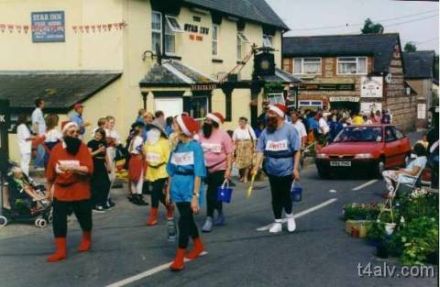 but The Roebuck continues to provide good food and real ales to the locals.
but The Roebuck continues to provide good food and real ales to the locals.
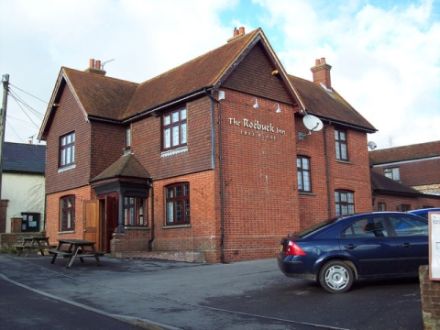
Photo by Patricia Steel
It is interesting to compare the above picture of the 1998 carnival with these next two, taken at a carnival in the 30's , where the theme
celebrated Amy Johnson's historic flights. The float was built by Leonard Adams and the "intrepid aviator" in the second picture is Gordon Clarke.
Both the Adams and the Clarkes are longstanding families within the village.
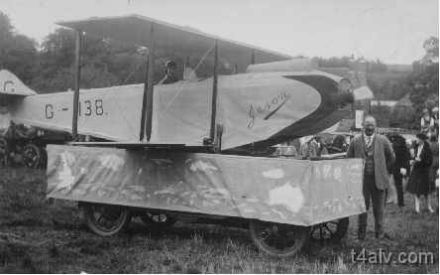
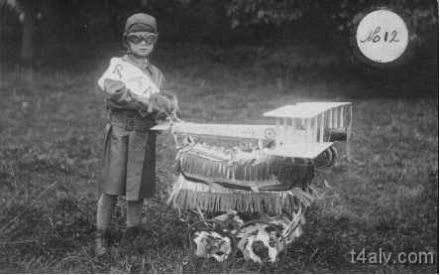
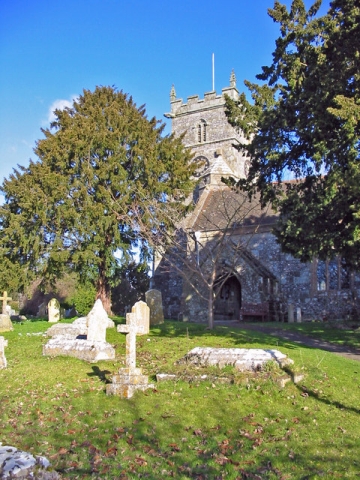
At the top of the village lies the church, dedicated to St. Mary The Virgin; of mainly Gothic architecture with an embattled square tower that rises above the local countryside.
The church is built of stone and inside there is a splendid wooden beamed roof. Included in it's treasures is a font from the 12th-century and commemorative brasses and monuments.
The churchyard has graves and tombs of local folk from past centuries,
but is also now maintained as a nature and wildlife friendly area, winning the first prize in the Best Managed category in the 2004 competition run by the Dorset Wildlife Trust.
As the High Street turns to the left in front of the church we reach The Hollows. The following images show that very little changed in the 70 odd years from the first photo (about 1920) until the second was taken in 1997. Now, however the area on the right is much more open, following the building of a number of houses on the site of the old Victory Tours coach depot, the entrance to which was behind and to the right of the photographer.
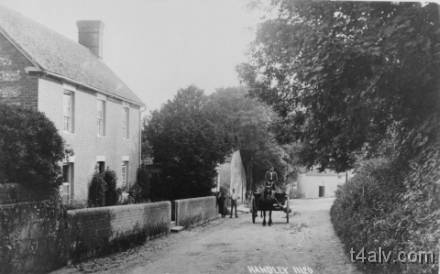
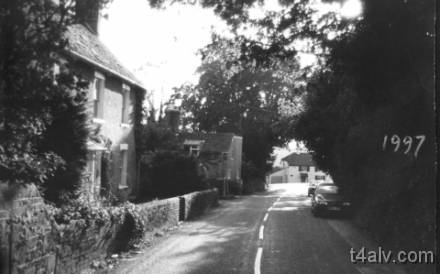
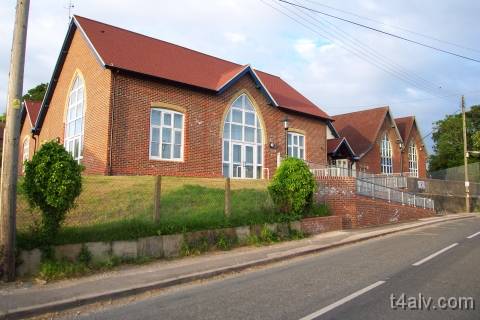 Finally, opposite the white house (behind which is the local funeral palour), seen in the centre of the above photos, where the road turns to the right, is the local school.
Finally, opposite the white house (behind which is the local funeral palour), seen in the centre of the above photos, where the road turns to the right, is the local school.
Sixpenny Handley First School caters for the local children and has done so for more than 100 years.
In early 2004 an extension was built to create additional classroom and activity space and to provide a new school hall. This extension was opened by HRH The Duchess of Gloucester on Thursday 8 July 2004.
HRH began her tour of the school in the original Victorian part of the building, and then moved to the new hall, where she formally opened the building extension.
The Duchess also unvielded a granite plaque, which was used as a capping stone to seal a time capsule that the school buried under the path in front of the new hall.
The photo shows the new hall in the foreground, whilst the two large windows on the far right are part of Victorian section of the school